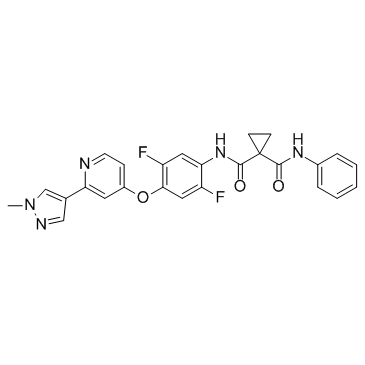| Description |
c-Kit-IN-1 is a potent inhibitor of c-Kit and c-Met with IC50s of <200 nM.
|
| Related Catalog |
|
| Target |
IC50: <200 nM (c-Met), <200 nM (c-Kit), <2 μM (KDR), <10 μM (PDGFRα), <10 μM (PDGFRβ)[1]
|
| In Vitro |
c-Kit-IN-1 is a c-Kit and c-Met inhibitor extracted from patent 2010051373A1, compound example 45, has an IC50 of <200 nM. c-Kit-IN-1 also inhibits KDR, PDGFR α and β with IC50s of <2 μM, <10 μM and <10 μM, respectively[1].
|
| Kinase Assay |
Activity of c-KIT kinase is determined by following the production of ADP from the kinase reaction through coupling with the pyruvate kinase/lactate dehydrogenase system. In this assay, the oxidation of NADH (thus the decrease at A340nm) is continuously monitored spectrophometrically. The reaction mixture (100 μL) contained c-KIT (cKIT residues T544-V976, from ProQinase, 5.4 nM), polyE4Y (1 mg/mL), MgC12 (10 mM), pyruvate kinase (4 units), lactate dehydrogenase (0.7 units), phosphoenol pyruvate (1 mM), and NADH (0.28 mM) in 90 mM Tris buffer containing 0.2 % octyl-glucoside and 1% DMSO, pH 7.5. Test compounds (e.g., c-Kit-IN-1) are incubated with c-KIT and other reaction reagents at 22°C for <2 min before ATP (200 μM) is added to start the reaction. The absorption at 340 nm is monitored continuously for 0.5 hours at 30°C on Polarstar Optima plate reader (BMG). The reaction rate is calculated using the 0 to 0.5 h time frame. Percent inhibition is obtained by comparison of reaction rate with that of a control (i.e. with no test compound). IC50 values are calculated from a series of percent inhibition values determined at a range of inhibitor concentrations using software routines as implemented in the GraphPad Prism software package[1].
|
| Cell Assay |
A serial dilution of test compounds (e.g., c-Kit-IN-1) are dispensed into a 96-well black clear bottom plate. For each cell line, five thousand cells are added per well in 200 μL complete growth medium. Plates are incubated for 67 hours at 37 degrees Celsius, 5% CO2, 95% humidity. At the end of the incubation period 40 μL of a 440 μM solution of resazurin in PBS is added to each well and incubated for an additional 5 hours at 37 degrees Celsius, 5% CO2, 95% humidity. Plates are read on a Synergy2 reader using an excitation of 540 nM and an emission of 600 nM. Data is analyzed using Prism software to calculate IC50 values[1].
|
| References |
[1]. Daniel L. Flynn, et al. Cyclopropane amides and analogs exhibiting anti-cancer and anti-proliferative activities. WO 2010051373 A1
|
